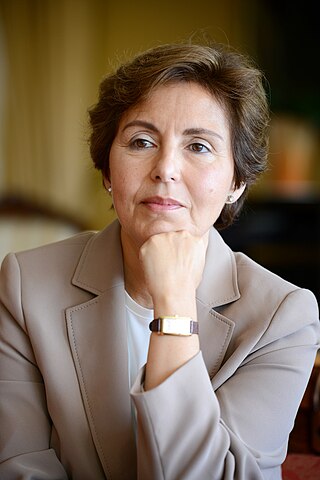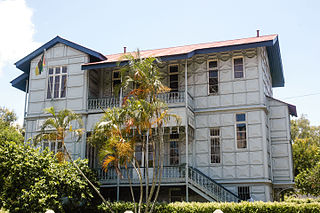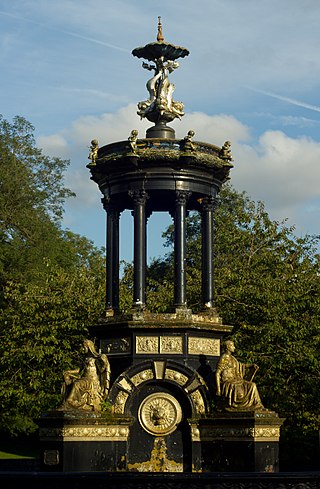Related Research Articles

A pier is a raised structure that rises above a body of water and usually juts out from its shore, typically supported by piles or pillars, and provides above-water access to offshore areas. Frequent pier uses include fishing, boat docking and access for both passengers and cargo, and oceanside recreation. Bridges, buildings, and walkways may all be supported by architectural piers. Their open structure allows tides and currents to flow relatively unhindered, whereas the more solid foundations of a quay or the closely spaced piles of a wharf can act as a breakwater, and are consequently more liable to silting. Piers can range in size and complexity from a simple lightweight wooden structure to major structures extended over 1,600 m (5,200 ft). In American English, a pier may be synonymous with a dock.

The West Pier is a ruined pier in Brighton, England. It was designed by Eugenius Birch and opened in 1866. It was the first pier to be Grade I listed in England but has become increasingly derelict since its closure to the public in 1975. As of 2024 only a partial metal framework remains.

James Heartfield is a British lecturer and historian.

The Great Stink was an event in Central London during July and August 1858 in which the hot weather exacerbated the smell of untreated human waste and industrial effluent that was present on the banks of the River Thames. The problem had been mounting for some years, with an ageing and inadequate sewer system that emptied directly into the Thames. The miasma from the effluent was thought to transmit contagious diseases, and three outbreaks of cholera before the Great Stink were blamed on the ongoing problems with the river.

Steve Roud is the creator of the Roud Folk Song Index and an expert on folklore and superstition. He was formerly Local Studies Librarian for the London Borough of Croydon and Honorary Librarian of the Folklore Society.

Llandudno Pier is a Grade II* listed pier in the seaside resort of Llandudno, North Wales, United Kingdom. At 2,295 feet (700 m), the pier is the longest in Wales and the fifth longest in England and Wales. In 2005, was voted "Pier of the Year 2005" by the members of the National Piers Society.

John Julian Timothy Jeal, known as Tim Jeal, is a British biographer of notable Victorians and is also a novelist. His publications include a memoir and biographies of David Livingstone (1973), Lord Baden-Powell (1989), and Sir Henry Morton Stanley (2007).

Charles Henry Driver FRIBA was a significant British architect of the Victorian era, with a reputation for pioneering use of ornamental iron work for which he was seen as a leading authority.

Victoria Leeds is a shopping district and leisure area in central Leeds, comprising the 1990 Victoria Quarter, an arcaded complex of restored 19th century and contemporary shopping arcades, and the 2016 Victoria Gate development. Notable for its role in the regeneration of Leeds' city centre, and a programme of restoration and reuse which included commissiong the largest work of stained glass work in Europe, designed by artist Brian Clarke, to cover the newly-pedestrianised Queen Victoria Street, the 1990 scheme created a covered retail district of linked arcades. In 2016 ,the Victoria Quarter was merged with the newly built Victoria Gate complex to form the largest premium retail and leisure venue in Northern England. The district includes a casino and major stores such as Harvey Nichols and John Lewis and Partners.
Andrew Mangham is a British literary critic and professor at the University of Reading. He is best known for his work on Victorian literature.
An iron founder in its more general sense is a worker in molten ferrous metal, generally working within an iron foundry. However, the term 'iron founder' is usually reserved for the owner or manager of an iron foundry, a person also known in Victorian England as a 'master'. Workers in a foundry are generically described as 'foundrymen'; however, the various craftsmen working in foundries, such as moulders and pattern makers, are often referred to by their specific trades.

Dolphin lamp standards provide electric light along much of the Thames Embankment in London, United Kingdom. Two stylised dolphins or sturgeons writhe around the base of a standard lamp post, supporting a fluted column bearing electric lights in an opaque white globe, topped by a metal crown. Many of the lamps are mounted on granite plinths.

Gülru Necipoğlu is a Turkish American professor of Islamic Art/Architecture. She has been the Aga Khan Professor and Director of the Aga Khan Program for Islamic Architecture at Harvard University since 1993, where she started teaching as Assistant Professor in 1987. She received her Harvard Ph.D. in the Department of History of Art and Architecture (1986), her BA in Art History at Wesleyan, her high school degree in Robert College, Istanbul (1975). She is married to the Ottoman historian and Harvard University professor Cemal Kafadar. Her sister is the historian Nevra Necipoğlu.
Lynda Nead is a British curator and art historian. She is currently the Pevsner Chair of the History of Art at Birkbeck, University of London. Nead's work studies British art, media, culture and often focuses on gender. Nead is a fellow of the British Academy, the Royal Historical Society and of the Academia Europaea.
Theresa Ann "Tag" Gronberg is an art historian with Birkbeck College, University of London. She is a specialist in the art of the Vienna Secession and Viennese coffeehouse culture. Her research interests also include gender and visual culture in 1920s France.
Mary Caroline McLeod is a professor of architectural history and theory at Columbia University known for her examination of modern architecture, especially the work of Le Corbusier. She is a fellow of the Society of Architectural Historians, and has received many fellowships and awards, including a Brunner Award, Fulbright Fellowship, NEH award, and grants from New York Council of the Arts and the Graham Foundation.
Patrick Curry is an independent Canadian-born British scholar who has worked and taught on a variety of subjects from cultural astronomy to divination, the ecology movement, and the nature of enchantment. He is known for his studies of J. R. R. Tolkien.
Andrew MayFRAS is an Australian social historian. He is a professor of Australian history in the School of Historical and Philosophical Studies of the University of Melbourne.

The Casa de Ferro is a historic prefabricated iron building located in Maputo, Mozambique. Originally built in Belgium, the structure was bought by the Portuguese colonial government and reassembled in 1892 in Maputo. It was intended to serve as the residence of the Governor of the District of Lourenço Marques.

The Saracen Fountain is a large, ornate fountain located in Alexandra Park, Glasgow, Scotland. It was made of cast iron by Macfarlane & Co.'s Saracen Foundry for the 1901 Glasgow International Exhibition and presented to the city as a gift by foundry owner Walter Macfarlane. It is influenced by the Choragic Monument of Lysicrates in Athens.
References
- 1 2 3 Dobraszczyk, Paul. "Curriculum vitae". Ragpickinghistory.co.uk. Retrieved 20 August 2023.
- ↑ Reviews:
- Pike, David L. (2012). "Into the Belly of the Beast: Exploring London's Victorian Sewers, by Paul Dobraszczy". Victorian Studies . 55 (1): 151–3. doi:10.2979/victorianstudies.55.1.151.
- Hwang, Haewon (2012). "Into the Belly of the Beast, Conceiving the City, and A Mighty Mass of Brick and Smoke". Journal of Victorian Culture . 17 (1): 120–4. doi:10.1080/13555502.2011.611707.
- ↑ Coverage:
- Yu, Phoebe (24 June 2014). "Top 10 science and tech books for June: the double helix, addiction, London sewers and the infosphere". The Guardian . Retrieved 6 September 2023.
- ↑ Reviews:
- Forgan, Sophie (2017). "Iron, Ornament and Architecture in Victorian Britain: Myth and Modernity, Excess and Enchantment by Paul Dobraszczyk (review)". Technology and Culture . 58 (1): 271–273. doi:10.1353/tech.2017.0018.
- Ferry, Kathryn (2017). "Iron, Ornament and Architecture in Victorian Britain; Myth and Modernity, Excess and Enchantment". Journal of Victorian Culture . 22 (1): 136–9. doi:10.1080/13555502.2016.1234102.
- Hedrick, Christian A. (2016). "Review: Iron, Ornament and Architecture in Victorian Britain: Myth and Modernity, Excess and Enchantment, by Paul Dobraszczyk". Journal of the Society of Architectural Historians . 75 (3): 370–2. doi:10.1525/jsah.2016.75.3.370.
- Cubitt, Rachel (2013). "Iron, ornament and architecture in Victorian Britain: Myth and modernity, excess and enchantment by Paul Dobraszczyk". Historical Metallurgy . 47 (2): 165–6.
- Bremner, G. A. (2016). "Iron, Ornament and Architecture in Victorian Britain". Victorian Studies . 58 (3): 557–60. doi:10.2979/victorianstudies.58.3.18.
- ↑ Reviews:
- Thorne, Robert (2017). "Paul Dobraszczyk and Peter Sealy (eds), Function and Fantasy: Iron Architecture in the Long Nineteenth Century; Routledge (Abingdon and New York, 2016), xiv 295 pp. incl. 90 b&w ills, ISBN: 9781472430007, £95.00". Architectural History . 60: 355–357. doi:10.1017/arh.2017.19.
- ↑ Reviews:
- Bevan, Robert (25 August 2016). "The Tunnel Through Time: A New Route for an Old London Journey/ Global Undergrounds: Exploring Cities Within - review". Evening Standard . Retrieved 6 September 2023.
- Smith, Gregory (9 September 2016). "'Global Undergrounds': The Lost, Forgotten, and Hidden Places Beneath Our Feet". Popmatters . Retrieved 6 September 2023.
- ↑ Reviews:
- Aroleda, Pablo (2018). "Book review: The Dead City: Urban Ruins and the Spectacle of Decay". Urban Studies . 55 (13): 3048–50. doi:10.1177/0042098018786380. hdl: 10261/281340 .
- ↑ Reviews:
- Morshed, Adnan (2020). "Review: Future Cities: Architecture and the Imagination, by Paul Dobraszczyk". Journal of the Society of Architectural Historians . 79 (2): 232–3. doi:10.1525/jsah.2020.79.2.232.
- Ro, Christine. "Future Cities: Architecture and the Imagination". Environment and Urbanization. International Institute for Environment and Development . Retrieved 11 October 2023.
- ↑ Reviews:
- Miller, Keith (13 September 2021). "Squatters, desert cults and climate protestors: new book surveys the architecture of anarchist settlements". The Art Newspaper . Retrieved 11 October 2023.
- Miller, Timothy (2022). "Architecture and Anarchism: Building without Authority". Utopian Studies . 33 (2): 250–2. doi:10.5325/utopianstudies.33.2.0350.
- ↑ Discussions:
- Milburn, Josh (15 May 2023). "Episode 214: Animal Architecture with Paul Dobraszczyk". Knowing Animals . Retrieved 11 October 2023.